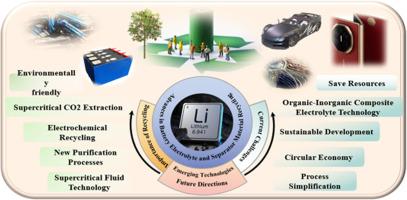循环经济,锂离子电池电解液和隔膜回收的挑战和解决方案
IF 7.9
2区 工程技术
Q1 CHEMISTRY, PHYSICAL
引用次数: 0
摘要
电解质和隔膜材料在锂离子电池(LIB)中起着至关重要的作用,它们提供离子传导通道,保证电极之间的有效隔离,以维持电池的安全和稳定的能量传递。随着全球电池LIB的快速增长,特别是在电动汽车和可再生能源存储系统领域,这些材料的回收利用变得尤为重要。回收锂离子电池电解质和隔膜材料,不仅可以减少对锂、钴等稀有资源的依赖,还可以显著减少废旧锂离子电池对环境的污染。然而,目前的回收技术存在回收效率低、分离纯化过程复杂、成本高、能耗高等局限性。本文详细讨论了这些技术挑战,并介绍了最新的技术进展,包括超临界CO2萃取、电化学回收和新的净化工艺。这些方法显示了提高回收效率和减少环境影响的潜力。此外,本文展望了未来的发展方向,强调通过技术创新,简化工艺流程,降低成本,提高资源再利用率,推动LIB产业走向循环经济和可持续发展。本文章由计算机程序翻译,如有差异,请以英文原文为准。

Circular economy, challenges and solutions in lithium-ion battery electrolyte and separator recycling
Electrolytes and separator materials play crucial roles in lithium-ion battery (LIB), providing ion conduction channels and ensuring effective isolation between electrodes to maintain battery safety and stable energy transfer. With the rapid growth of global battery LIB, especially in the fields of electric vehicles and renewable energy storage systems, the recycling of these materials has become particularly important. Recycling LIB electrolytes and separator materials can not only reduce the dependence on rare resources such as lithium and cobalt but also significantly reduce the environmental pollution caused by waste LIBs. However, current recycling technologies have many limitations, such as low recycling efficiency, complex separation and purification processes, high costs, and high energy consumption. This paper discusses these technical challenges in detail and introduces the latest technological progress, including supercritical CO2 extraction, electrochemical recycling, and new purification processes. These methods show the potential to improve recycling efficiency and reduce environmental impacts. In addition, this paper looks forward to future development directions and emphasizes promoting the LIB industry to move towards a circular economy and sustainable development through technological innovation to simplify the process flow, reduce costs, and improve resource reuse rates.
求助全文
通过发布文献求助,成功后即可免费获取论文全文。
去求助
来源期刊

Journal of Power Sources
工程技术-电化学
CiteScore
16.40
自引率
6.50%
发文量
1249
审稿时长
36 days
期刊介绍:
The Journal of Power Sources is a publication catering to researchers and technologists interested in various aspects of the science, technology, and applications of electrochemical power sources. It covers original research and reviews on primary and secondary batteries, fuel cells, supercapacitors, and photo-electrochemical cells.
Topics considered include the research, development and applications of nanomaterials and novel componentry for these devices. Examples of applications of these electrochemical power sources include:
• Portable electronics
• Electric and Hybrid Electric Vehicles
• Uninterruptible Power Supply (UPS) systems
• Storage of renewable energy
• Satellites and deep space probes
• Boats and ships, drones and aircrafts
• Wearable energy storage systems
 求助内容:
求助内容: 应助结果提醒方式:
应助结果提醒方式:


